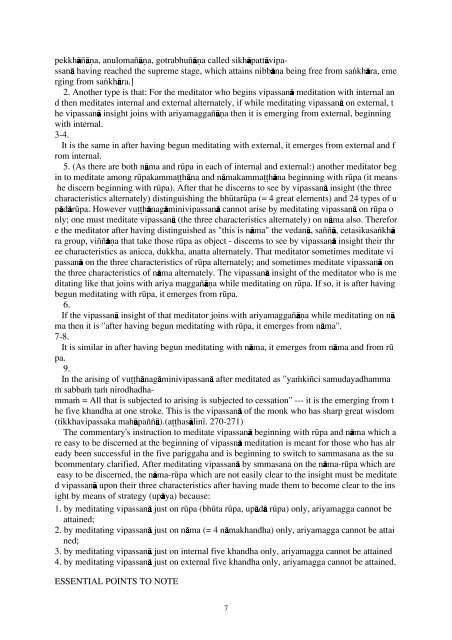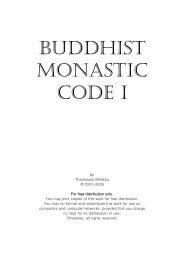Vipassana Kammatthana.pdf
Vipassana Kammatthana.pdf
Vipassana Kammatthana.pdf
Create successful ePaper yourself
Turn your PDF publications into a flip-book with our unique Google optimized e-Paper software.
pekkhåñåˆa, anulomañåˆa, gotrabhuñåˆa called sikhåpattåvipassanå<br />
having reached the supreme stage, which attains nibbåna being free from sa∫khåra, eme<br />
rging from sa∫khåra.]<br />
2. Another type is that: For the meditator who begins vipassanå meditation with internal an<br />
d then meditates internal and external alternately, if while meditating vipassanå on external, t<br />
he vipassanå insight joins with ariyamaggañåˆa then it is emerging from external, beginning<br />
with internal.<br />
3-4.<br />
It is the same in after having begun meditating with external, it emerges from external and f<br />
rom internal.<br />
5. (As there are both nåma and rËpa in each of internal and external:) another meditator beg<br />
in to meditate among rËpakamma håna and nåmakamma håna beginning with rËpa (it means<br />
he discern beginning with rËpa). After that he discerns to see by vipassanå insight (the three<br />
characteristics alternately) distinguishing the bhËtarËpa (= 4 great elements) and 24 types of u<br />
pådårËpa. However vu hånagåminivipassanå cannot arise by meditating vipassanå on rËpa o<br />
nly; one must meditate vipassanå (the three characteristics alternately) on nåma also. Therefor<br />
e the meditator after having distinguished as "this is nåma" the vedanå, saññå, cetasikasa∫khå<br />
ra group, viññåˆa that take those rËpa as object - discerns to see by vipassanå insight their thr<br />
ee characteristics as anicca, dukkha, anatta alternately. That meditator sometimes meditate vi<br />
passanå on the three characteristics of rËpa alternately; and sometimes meditate vipassanå on<br />
the three characteristics of nåma alternately. The vipassanå insight of the meditator who is me<br />
ditating like that joins with ariya maggañåˆa while meditating on rËpa. If so, it is after having<br />
begun meditating with rËpa, it emerges from rËpa.<br />
6.<br />
If the vipassanå insight of that meditator joins with ariyamaggañåˆa while meditating on nå<br />
ma then it is "after having begun meditating with rËpa, it emerges from nåma".<br />
7-8.<br />
It is similar in after having begun meditating with nåma, it emerges from nåma and from rË<br />
pa.<br />
9.<br />
In the arising of vu hånagåminivipassanå after meditated as "ya◊kiñci samudayadhamma<br />
◊ sabba◊ ta◊ nirodhadhamma◊<br />
= All that is subjected to arising is subjected to cessation" --- it is the emerging from t<br />
he five khandha at one stroke. This is the vipassanå of the monk who has sharp great wisdom<br />
(tikkhavipassaka mahåpaññå).(a hasålin¥. 270-271)<br />
The commentary's instruction to meditate vipassanå beginning with rËpa and nåma which a<br />
re easy to be discerned at the beginning of vipassnå meditation is meant for those who has alr<br />
eady been successful in the five pariggaha and is beginning to switch to sammasana as the su<br />
bcommentary clarified. After meditating vipassanå by smmasana on the nåma-rËpa which are<br />
easy to be discerned, the nåma-rËpa which are not easily clear to the insight must be meditate<br />
d vipassanå upon their three characteristics after having made them to become clear to the ins<br />
ight by means of strategy (upåya) because:<br />
1. by meditating vipassanå just on rËpa (bhËta rËpa, upådå rËpa) only, ariyamagga cannot be<br />
attained;<br />
2. by meditating vipassanå just on nåma (= 4 nåmakhandha) only, ariyamagga cannot be attai<br />
ned;<br />
3. by meditating vipassanå just on internal five khandha only, ariyamagga cannot be attained<br />
4. by meditating vipassanå just on external five khandha only, ariyamagga cannot be attained.<br />
ESSENTIAL POINTS TO NOTE<br />
7






